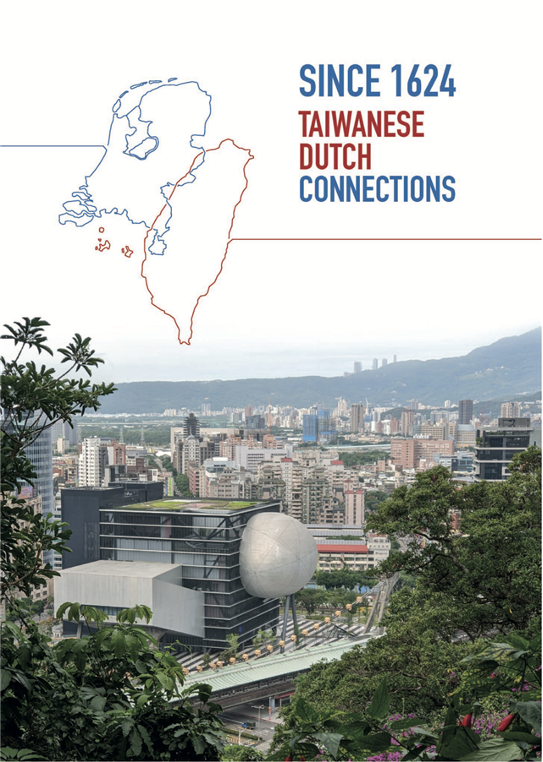Editors: Dr. Mila Davids, Dr. Ann Heylen, Dr. Tim Riswick, Dr. Eric Berkers

Special Intro From Dr. Ann Heylen
On May 30th this year, the first day of the 13th International Symposium on Taiwan Culture, we launched the publication Since 1624: Taiwanese-Dutch Connections in the presence of Netherlands Office Taipei Representative Guido Tielman and other dignitaries. This volume is meant for the general public and as a gift to the diplomatic and corporate friends of Taiwan and the Netherlands.
This project was conceived in summer 2022, during a working lunch with Dr Mila Davids (蜜蠟) and Eric Berkers of The Foundation for the History of Technology (SHT) at the Eindhoven University of Technology (TU/e). Together with Tim Riswick at Radboud University and the helpful staff at SHT, we set to work. Christopher Joby joined us as the English language editor, and in February 2024, Darryl Sterk (石岱崙) brought Dr Frank Yu-Tsuen Hsu (徐雨村) onto the team to help produce a Chinese version.
The making of this book taught me that when investigating the historical Taiwanese-Dutch relations, we must also reflect on how these determine the present situation. An analysis of the current economic, social, cultural, and sustainable developments in both countries will always take the historical roots into account. Significantly, from the outset of this project, we received a lot of interest from scholars of various disciplines, which inspired our team to establish a cross-border interdisciplinary research network into the connections between Taiwan and the Netherlands.
The year 2024 has special significance in Taiwan. Many activities are being held related to the 400-year anniversary of Dutch Formosa and the city of Tainan. For the Dutch, there was a particular allure. As part of the ever-expanding reach of the VOC (Dutch East India Company), the island of Formosa (present-day Taiwan), with its strategic location in the Western Pacific, emerged as a focal point of diplomacy and a critical stopover on trade routes, particularly the route that brought silver and other precious metals from Japan to the VOC’s trading post of Batavia on the island of Java. However, Dutch-Taiwan relations go far beyond the VOC era and economic cooperation has continued throughout the 20th and 21stcenturies. Besides water management, land reclamation and wetland management, harbor infrastructure, and other environmental policies crucial to development in both Taiwan and the Netherlands, the two nations also share an interest in trade, technological innovation, and the high-tech semi-conductor industry. “Culture, Language & People,” “Water & Land,” and “Business & Trade” thus became the core themes of the book.Even though the 17th century Dutch presence in Taiwan did not last long, a diverse group of scholars in Taiwan continue to research that period. Some of them are students of the late Tsao Yung-ho (曹永和) at NTU or Leonard Blussé (包樂史)at Leiden University, including Weichung Cheng (鄭維中), Hsin-hui Chiu (邱馨慧), Jungchen Chen (陳瑢真), Natalie Everts. Chapters by Peter Kang (康培德), Joris van den Tol, Kai Yiu Chan (陳計堯), Zhao-Zong Wu (吳兆宗) and Llyn Scott (施琳達) equally draw from primary sources, be it of a cartographic or textual nature. Christopher Joby and myself completed the contextualization of the 17th century chapters, while Netherlands-based researchers provided chapters on interactions with water, land, trade, and business, often in co-authorship with Taiwanese specialists, such as Sinite Yu (游進裕), Song-Yue Yang (楊松岳), Tsai-ying Lu (呂采穎), and Yu-fong Wang (王御風). Wei-ken Hung (洪偉肯) and Lin-Lin Chen (陳玲鈴) reflect on the industrial design company Pilot Fish (荷商派立), while Inge Goudsmit (伊葛) and Shih-Hui Teng (鄧詩慧) discuss the contributions of Dutch innovations in architectural design. Some attention has also been given to a number of individuals, business and academic personalities who have made special contributions to the relations between Taiwan and the Netherlands: Paul Philips (羅益強), Simeon Vonk (馮可聰), and Paul-Frans van der Putten wrote on renowned scholar of Daoism Kristofer Schipper (施舟人), Willem van Lennep a.k.a. Liu Yuan-tao (劉源桃), and sinologist Leonard Blussé, respectively. Junior researchers Chantalle Rietdijk (李莎蕊 co-authored with Yi-Ling Chen 陳怡伶) and Viola van Onselen (安薇娜), both recent Ph.D. graduates from the Department of Geography at NTNU, round out the list of contributors. At 2000 words, two illustrations, and suggestions for further reading, the chapters are concise, accessible, and suitable for classroom use. Not only that, but discussion goes on as two one-day workshops with contributors will be organized in Den Haag and at Radboud University respectively.